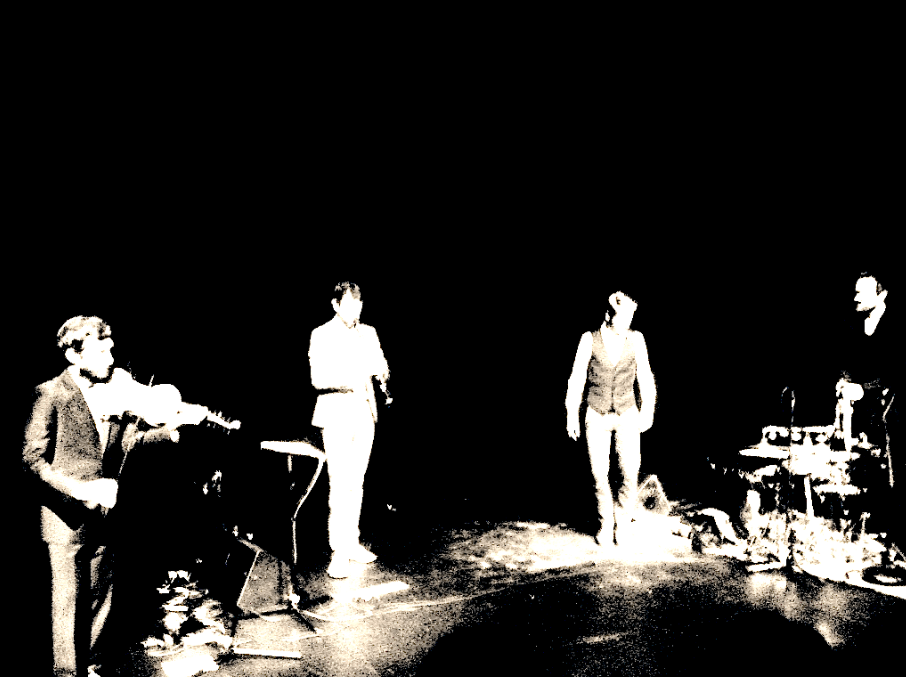(Disclosure – The author knows them.)
There is so much to this album – in the variety of styles, the creativity in the playing, the inventiveness of accompaniment, the range of moods, the depth of musical thinking, the beauty of melody and of rhythm – subtle though some of it may be, it is a gift to be able to listen to it.
Caoimhín Ó Raghallaigh‘s Irish traditional music roots come through but not strongly. This is not a trad album. The opening track, What what what, is, I suppose, in reel time, but typical of his where-trad-begins-to-disintegrate approach, it has an openness that allows Seán MacErlaine‘s clarinet to not only drone and colour but also to wander. In fact, there’s a beautiful, moody bridge section that you never get in a traditional tune, and superb use of rhythm changes throughout.

Caoimhín Ó Raghallaigh, Seán Mac Erlaine, Nic Gareiss and Petter Berndalen at the Riverbank Arts Centre, 25 September 2013
Through the album, at different times Seán tracks mainmelodyman Caoimhín (and occasionally vice versa), at others he wanders off into brief harmonies, and at others he goes for it, launching into improvisation. Mostly his improv approach is more ambient, abstract and effects than scaling and roaming and melody-stretching. (His effects include making the clarinet sound like a didgeridoo and voicing into the mouthpiece in a kind of singing-playing overlap.)
There is a conscious limitation at work here, a restraint, that is also evident in the length and material of the tunes themselves. All bar one of the tracks are under five minutes, eight of the twelve are under four minutes, in fact. The Enkies is just over a minute and features a quirky two-ish part melody (AA1B AA1B A) on just fiddle and clarinet. Some of the tracks are based on quite simple tunes toyed with and bolstered by mood-setting intros, outros and bridges. The longer tracks (Caoimhín’s Mausoleum ::: Ellipisses and the traditional Big Pat’s ::: Dan Breen’s, for instance) are very developed, and even though the shorter tunes are substantial in their ways, I would have preferred a bit more development in some of them. You can tell there’s even more in these musicians, lots more.
While Caoimhín has a great ear for a tune and a majority of the compositions have his input, arguably the catchiest tune and certainly the most upbeat on the album is Seán’s Tree on the Downs. It’s got a “whistle a happy tune” quality and you could picture Gene Kelly dancing down the street to it.
Unusually, the album features a dancer. I have a few traditional music albums that feature the sound of dancing as a by-product or as a token, but this is very different. Nic Gareiss, surely a dancing phenomenon, has always been central to this ‘project’ and his contribution to the recording had to be ‘solved’. It can be lost in some tracks on a background-casual listen through speakers (thought not in Céad Moladh or Big Pat’s ::: Dan Breen’s), but when you pay attention or put it through the headphones, he’s right there in the middle of things, percussing but also adding texture and even mood, at times conjoining and at others contrasting with the melody, augmenting and lifting it or ‘countering’ it. And if you’ve seen him dance in the flesh, his sound on the recording is sometimes enough to evoke his form – which says something about his individuality. Petter Berndalen‘s percussion is also very front and centre, the variety of sounds and timbres amounting to a melodic contribution at times that could easily be overlooked by ears seeking out the melodies, and thereby diminish the experience considerably. (Petter has a solo album consisting of 40 minutes of solo percussion based on traditional Swedish folk music.)
It’s cool to like these guys (– John Kelly has played the album almost to death of late, including four tracks in a row today), and that’s as should be, but I hope the people that decide these things are really listening to the music. Mostly the mood is quite elegiac, even sombre, more so than many might be expecting from the live shows and the ‘branding’. To anyone familiar, though, with Caoimhín’s solo album Where the One-Eyed Man is King, and Seán’s last album Long After the Music is Gone this will be no surprise. Fair dues to them for not compromising their art for the sake of catchyness.
RATING: GOTTA GET IT (FUTURE SOUNDS)
Buy it here >>>
Download it here >>>

